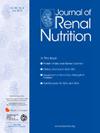用多普勒超声评估黑巧克力对健康志愿者血压和肾血流动力学的急性影响。
IF 3.2
3区 医学
Q2 NUTRITION & DIETETICS
引用次数: 0
摘要
目的:黑巧克力(DC)富含可可,一种具有抗氧化和抗高血压特性的物质。DC对肾脏血流动力学的影响尚不清楚。这项随机、安慰剂对照研究的目的是研究与不含可可的白巧克力(WC)相比,在静息和交感刺激时,DC是否会引起血压和肾灌注的变化,这是多普勒超声评估的结果。方法:17名年龄为42±14岁的健康志愿者(47%为女性)被随机分为两组,一组为1g/kg DC(70%可可),另一组为1g/kg WC。肾脏阻力指数(RRI)是肾脏血管阻力的代表,在食用巧克力前和食用巧克力后两小时进行测量。采用Finapres®NOVA血流动力学监测系统测量血压(BP)、心率和心输出量。在每个时间点,以3分钟的握力测试作为交感刺激;在握拍过程中,测量补充RRI值。两周后,用另一种巧克力重复了同样的测试。结果:DC摄入使RRI从0.62±0.04降至0.60±0.04 (p=0.039),而WC摄入后RRI无变化(前:0.62±0.05,后:0.62±0.04,p=0.47)。在每周吃50克巧克力的参与者中,DC对血压没有影响,而在不经常吃巧克力的参与者中,SBP从115±17增加到122±15 mmHg (p=0.02)。握力运动使RRI从0.62±0.04降低到0.57±0.05 (p=0.001),加速时间从48.2±8.2增加到57.8±14 msec, p=0.009),同时血压、心率和心输出量增加。在年龄≥35岁的参与者中,手部运动对RRI的影响因摄入DC而减弱。结论:摄入DC导致RRI急性降低,提示肾内血管舒张,而WC没有影响。血压仅在不经常食用DC的人群中升高,这表明经常食用DC的人群已经习惯了DC的血压调节作用。握力锻炼可导致下肢迟缓样的多普勒曲线。在老年参与者中,DC减弱了这种效应,这表明DC抵消了这些志愿者中交感神经诱导的肾内血管收缩。本文章由计算机程序翻译,如有差异,请以英文原文为准。
The Acute Effect of Dark Chocolate on Blood Pressure and Renal Hemodynamics as Assessed With Doppler Ultrasound in Healthy Volunteers
Objective
Dark chocolate (DC) is rich in cocoa, a substance with antioxidative and antihypertensive properties. The effect of DC on renal hemodynamics is poorly understood. The aim of this randomized, placebo-controlled study was to investigate whether DC induces changes in blood pressure (BP) and renal perfusion, as assessed with Doppler ultrasound – both at rest and during sympathetic stimulation – compared to cocoa-free white chocolate (WC).
Methods
Seventeen healthy volunteers aged 42 ± 14 years (47% women) were randomized to eat 1 dose of 1 g/kg of DC (70% cocoa) or 1 g/kg of WC. The renal resistive index (RRI), a proxy of intra-renal vascular resistance, was measured just before and 2 hours after chocolate consumption. BP, heart rate, and cardiac output were measured with the Finapres NOVA hemodynamic monitoring system. At each time point, a 3-minute handgrip (HG) test was performed as sympathetic stimulus; during the HG, supplementary RRI values were measured. Two weeks later, the same exams were repeated with the other type of chocolate.
Results
DC intake decreased RRI from 0.62 ± 0.04 to 0.60 ± 0.04 (P = .039), whereas RRI did not change after the intake of WC (before: 0.62 ± 0.05, after: 0.62 ± 0.04, P = .47). DC had no effect on BP in participants consuming >50 g chocolate/week, whereas systolic blood pressure increased from 115 ± 17 to 122 ± 15 mmHg (P = .02) in nonregular chocolate eaters. HG exercise lowered the RRI from 0.62 ± 0.04 to 0.57 ± 0.05 (P = .001) and prolonged acceleration times (from 48.2 ± 8.2 to 57.8 ± 14 msec, P = .009), while increasing BP, heart rate, and cardiac output. In participants aged ≥35 years, the effect of HG exercise on RRI was attenuated by DC ingestion.
Conclusions
The ingestion of DC led to an acute reduction in RRI, suggesting intra-renal vasodilation, whereas WC had no effect. BP only increased in nonregular DC eaters, suggesting that regular DC eaters accustomed to the BP-modifying effects of DC. HG exercise led to a tardus parvus-like pattern of Doppler curves. This effect was attenuated by DC in older participants, suggesting that DC counterbalances the sympathetically induced intra-renal vasoconstriction in these volunteers.
求助全文
通过发布文献求助,成功后即可免费获取论文全文。
去求助
来源期刊

Journal of Renal Nutrition
医学-泌尿学与肾脏学
CiteScore
5.70
自引率
12.50%
发文量
146
审稿时长
6.7 weeks
期刊介绍:
The Journal of Renal Nutrition is devoted exclusively to renal nutrition science and renal dietetics. Its content is appropriate for nutritionists, physicians and researchers working in nephrology. Each issue contains a state-of-the-art review, original research, articles on the clinical management and education of patients, a current literature review, and nutritional analysis of food products that have clinical relevance.
 求助内容:
求助内容: 应助结果提醒方式:
应助结果提醒方式:


